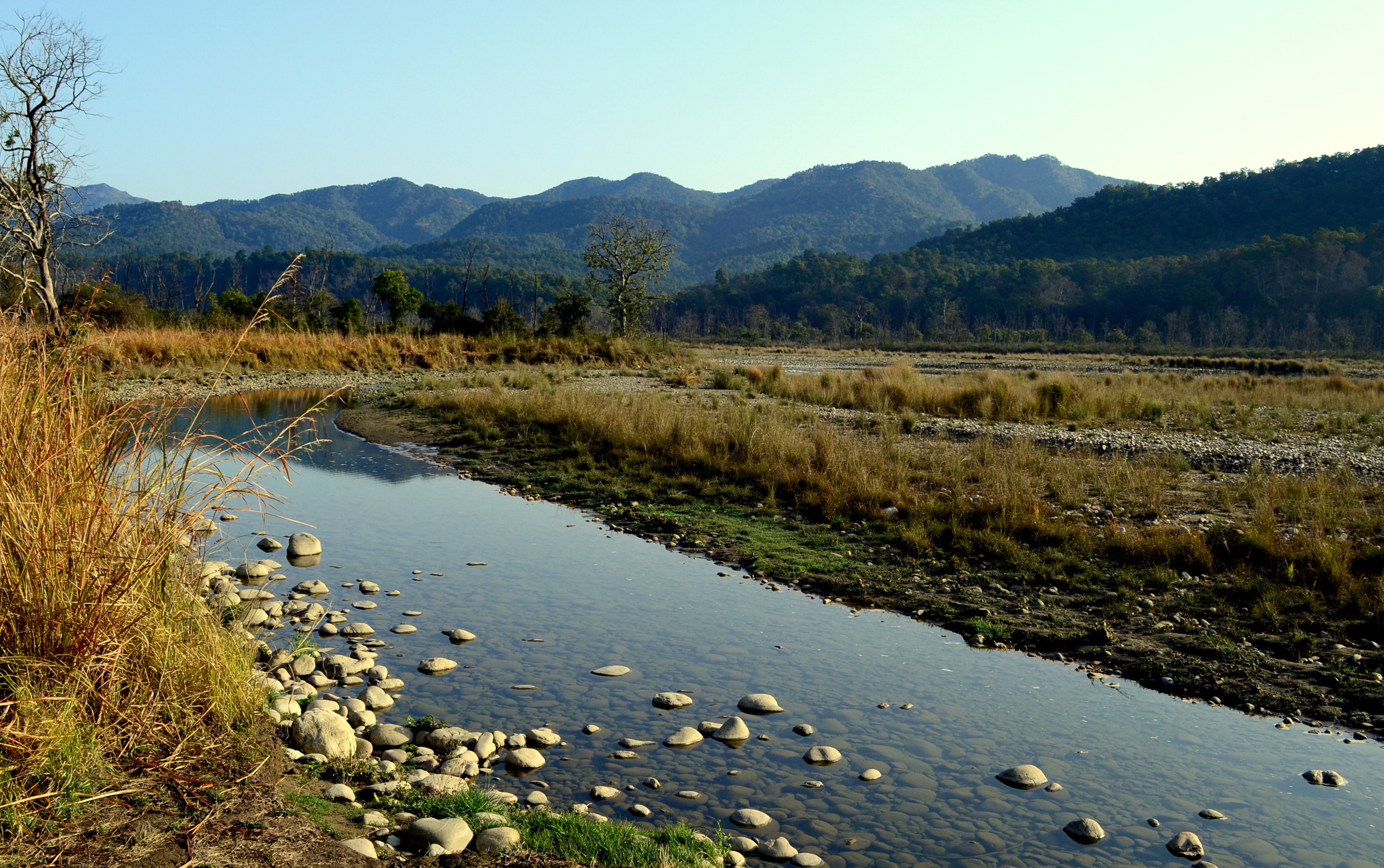|
Chuka Man-eater
The Chuka man-eating tiger was a male Bengal tiger responsible for the death of three boys from Thak village in the Ladhya Valley in India in 1937. It was shot by Jim Corbett in April 1937 who noted that the animal had a broken canine tooth and several gunshot wounds in various parts of his body. First attacks Before becoming a man-eater, the tiger used to frequent the firetrack running between the villages Chuka (village), Chuka and Kot Kindri, frequently attacking travellers passing along the path. In the book ''Temple Tiger and more Man-Eaters of Kumaon'', Corbett describes two such incidents which occurred in the winter of 1936–37. In the first incident, a villager was driving two bullocks along the path to Chuka when a tiger suddenly appeared in his path. The villager interposed between the tiger and his wikt:bullock, bullocks attempting to drive the tiger away. Taking advantage of the diversion created in their favour, the bullocks bolted away to the village. The tiger, ... [...More Info...] [...Related Items...] OR: [Wikipedia] [Google] [Baidu] |
Bengal Tiger
The Bengal tiger is a population of the ''Panthera tigris tigris'' subspecies and the nominate tiger subspecies. It ranks among the largest wild cats alive today. It is estimated to have been present in the Indian subcontinent since the Late Pleistocene for about 12,000 to 16,500 years. Its historical range covered the Indus River valley until the early 19th century, almost all of India, southern Nepal, Bangladesh, Bhutan and southwestern China. Today, it inhabits India, Bangladesh, Nepal, Bhutan, and southwestern China. It is threatened by poaching, habitat loss and habitat fragmentation. As of 2022, the Bengal tiger population was estimated at 3,167–3,682 individuals in India, 316–355 individuals in Nepal, 131 individuals in Bhutan and around 114 individuals in Bangladesh. Taxonomy ''Felis tigris'' was the scientific name used by Carl Linnaeus in 1758 for the tiger. It was subordinated to the genus ''Panthera'' by Reginald Innes Pocock in 1929. Bengal is the traditional ... [...More Info...] [...Related Items...] OR: [Wikipedia] [Google] [Baidu] |
Vulture
A vulture is a bird of prey that scavenges on carrion. There are 23 extant species of vulture (including condors). Old World vultures include 16 living species native to Europe, Africa, and Asia; New World vultures are restricted to North and South America and consist of seven identified species, all belonging to the Cathartidae family. A particular characteristic of many vultures is a bald, unfeathered head. This bare skin is thought to keep the head clean when feeding, and also plays an important role in thermoregulation. Vultures have been observed to hunch their bodies and tuck in their heads in the cold, and open their wings and stretch their necks in the heat. They also urinate on themselves as a means of cooling their bodies. A group of vultures in flight is called a "kettle", while the term "committee" refers to a group of vultures resting on the ground or in trees. A group of vultures that are feeding is termed a "wake". Taxonomy Although New World vulture ... [...More Info...] [...Related Items...] OR: [Wikipedia] [Google] [Baidu] |
1937 Animal Deaths
Events January * January 1 – Anastasio Somoza García becomes President of Nicaragua. * January 5 – Water levels begin to rise in the Ohio River in the United States, leading to the Ohio River flood of 1937, which continues into February, leaving 1 million people homeless and 385 people dead. * January 15 – Spanish Civil War: The Second Battle of the Corunna Road ends inconclusively. * January 23 – Moscow Trials: Trial of the Anti-Soviet Trotskyist Center – In the Soviet Union 17 leading Communists go on trial, accused of participating in a plot led by Leon Trotsky to overthrow Joseph Stalin's regime, and assassinate its leaders. * January 30 – The Moscow Trial initiated on January 23 is concluded. Thirteen of the defendants are Capital punishment, sentenced to death (including Georgy Pyatakov, Nikolay Muralov and Leonid Serebryakov), while the rest, including Karl Radek and Grigory Sokolnikov are sent to Gulag, labor camps and later murdered. They were i ... [...More Info...] [...Related Items...] OR: [Wikipedia] [Google] [Baidu] |
Deaths Due To Tiger Attacks
Death is the end of life; the irreversible cessation of all biological functions that sustain a living organism. Death eventually and inevitably occurs in all organisms. The remains of a former organism normally begin to decompose shortly after death. Some organisms, such as '' Turritopsis dohrnii'', are biologically immortal; however, they can still die from means other than aging. Death is generally applied to whole organisms; the equivalent for individual components of an organism, such as cells or tissues, is necrosis. Something that is not considered an organism, such as a virus, can be physically destroyed but is not said ''to die'', as a virus is not considered alive in the first place. As of the early 21st century, 56 million people die per year. The most common reason is aging, followed by cardiovascular disease, which is a disease that affects the heart or blood vessels. As of 2022, an estimated total of almost 110 billion humans have died, or roughly 94% of ... [...More Info...] [...Related Items...] OR: [Wikipedia] [Google] [Baidu] |
History Of Uttarakhand
Uttarakhand is a Himalayan state in North India, nestled between the Tibetan Plateau and the Indo-Gangetic Plains. The name, which means "northern land" or "section" or "northern part" in Sanskrit was made popular in the 80s as part of the wider statehood struggle within the region. Present day Uttarakhand comprises the historical administrative Garhwal and Kumaon divisions. Early History Initially, it was believed that due to harsh climate and mountainous terrain, this was a barren and uninhabited land. But after various excavations and the study of ancient literature, it is now established that the history of Uttarakhand goes back to Stone Age. Evidences of Stone Age settlements have been found in various parts of Kumaon and Garhwal, particularly notable are the rock shelters at Lakhudyar, Almora. In the Puranas, Uttarakhand was the ancient term for the central Indian Himalayas. The region is mentioned in early Hindu texts as the combined region of Kedarkhand and Manas ... [...More Info...] [...Related Items...] OR: [Wikipedia] [Google] [Baidu] |
Individual Tigers In India
An individual is one that exists as a distinct entity. Individuality (or self-hood) is the state or quality of living as an individual; particularly (in the case of humans) as a person unique from other people and possessing one's own needs or goals, rights and responsibilities. The concept of an individual features in many fields, including biology, law, and philosophy. Every individual contributes significantly to the growth of a civilization. Society is a multifaceted concept that is shaped and influenced by a wide range of different things, including human behaviors, attitudes, and ideas. The culture, morals, and beliefs of others as well as the general direction and trajectory of the society can all be influenced and shaped by an individual's activities. Etymology From the 15th century and earlier (and also today within the fields of statistics and metaphysics) ''individual'' meant " indivisible", typically describing any numerically singular thing, but sometimes meanin ... [...More Info...] [...Related Items...] OR: [Wikipedia] [Google] [Baidu] |
Man-eating Animals In India
Anthropophagy may refer to: * Human cannibalism, the act or practice of humans eating the flesh or internal organs of other human beings ** Androphagi, an ancient Scythian tribe whose existence was recorded by ancient Greco-Roman authors ** Anthropophage, a mythical race of cannibals described by the playwright William Shakespeare ** Autocannibalism, the practice of eating parts of one's own body ** Child cannibalism, the act of eating a child or fetus ** Endocannibalism, a practice of cannibalism in one's own locality or community ** Exocannibalism, the consumption of flesh from humans that do not belong to one's close social group ** Medical cannibalism, the consumption of parts of the human body, dead or alive, to treat or prevent diseases * Man-eating animal, an individual animal or being that preys on humans as a pattern of hunting behavior * Man-eating plant, a legendary carnivorous plant large enough to kill and consume a human or other large animal * Anthropophagic movement, ... [...More Info...] [...Related Items...] OR: [Wikipedia] [Google] [Baidu] |
Corbett National Park
Jim Corbett National Park is a List of national parks of India, national park in India located in the Nainital district of Uttarakhand state. The first national park in India, it was established in 1936 during the British Raj and named ''Hailey National Park'' after Malcolm Hailey, 1st Baron Hailey, William Malcolm Hailey, a governor of the United Provinces of British India, United Provinces in which it was then located. In 1956, nearly a decade after India's independence, it was renamed ''Corbett National Park'' after the hunter and naturalist Jim Corbett, who had played a leading role in its establishment and had died the year before. The park was the first to come under the Project Tiger initiative.Riley & Riley 2005: 208 Corbett National Park comprises area of hills, riverine belts, marshy depressions, grasslands and a large lake. The elevation ranges from . Winter nights are cold but the days are bright and sunny. It rains from July to September. The park has Terai, sub- ... [...More Info...] [...Related Items...] OR: [Wikipedia] [Google] [Baidu] |
Man-Eaters Of Kumaon
''Man-Eaters of Kumaon'' is a 1944 book written by hunter-naturalist Jim Corbett. It details the experiences that Corbett had in the Kumaon region of India from the 1900s to the 1930s, while hunting man-eating Bengal tigers and Indian leopards. One tiger, for example, was responsible for over 400 human deaths. ''Man-Eaters of Kumaon'' is the best known of Corbett's books, and contains 10 stories of tracking and shooting man-eaters in the Indian Himalayas during the early years of the twentieth century. The text also contains incidental information on flora, fauna and village life. Seven of the stories were first published privately as ''Jungle Stories''. Book contents * Introduction by Sir Maurice Hallett * Preface by Lord Linlithgow * Authors Note: Causes of Man-eating in Tigers and Leopards * Champawat Man-eater: The story of the first man-eating tiger shot by Corbett in 1907. Reportedly the man-eater claimed 436 human victims in Nepal and India * Robin: Stories of Corb ... [...More Info...] [...Related Items...] OR: [Wikipedia] [Google] [Baidu] |
Champawat Tiger
Tiger attacks are a form of human–wildlife conflict which have killed more humans than attacks by any of the other big cats, with the majority of these attacks occurring in Bangladesh, India, Nepal, and Southeast Asia. Reasons for attacking Like most other predators, tigers tend to attack humans only while hunting or when they feel threatened. If a human comes too close and surprises a sleeping or feeding tiger, or a tigress with her cubs, the tiger is prone to respond with aggression. Tigers have also been known to attack humans in cases of "mistaken identity" (for example, if a human is crouching while collecting firewood, or cutting grass) and sometimes when a tourist gets too close. Some also recommend not riding a bicycle, or running in a region where tigers live, so as not to provoke their instinct to chase. Peter Byrne wrote about an Indian postman who was working on foot for many years without any problems with resident tigers, but was chased by a tiger soon after he s ... [...More Info...] [...Related Items...] OR: [Wikipedia] [Google] [Baidu] |
Guild Wars 2
''Guild Wars 2'' is a free-to-play, massively multiplayer online role-playing game developed by ArenaNet and published by NCSoft. Set in the fantasy world of Tyria, the core game follows the re-emergence of Destiny's Edge, a disbanded guild dedicated to fighting Elder Dragons, colossal Lovecraftian horror, Lovecraftian-esque entities that have seized control of Tyria in the time since the original ''Guild Wars (video game), Guild Wars'' (2005)'','' a plot line that concludes in the third expansion Guild Wars 2: End of Dragons, ''End of Dragons'' (2023). The game takes place in a persistent world with a story that progresses in Instance dungeon, instanced environments. ''Guild Wars 2'' is the fourth major entry in the Guild Wars, ''Guild Wars'' series, and claims to be unique in the MMO genre by featuring a storyline that is responsive to player actions, something which is common in single player role-playing games but rarely seen in multiplayer ones. A dynamic event system replac ... [...More Info...] [...Related Items...] OR: [Wikipedia] [Google] [Baidu] |
Fig-tree
''Ficus'' ( or ) is a genus of about 850 species of woody trees, shrubs, vines, epiphytes and hemiepiphytes in the family Moraceae. Collectively known as fig trees or figs, they are native throughout the tropics with a few species extending into the semi-warm temperate zone. The common fig (''F. carica'') is a temperate species native to southwest Asia and the Mediterranean region (from Afghanistan to Portugal), which has been widely cultivated from ancient times for its fruit, also referred to as figs. The fruit of most other species are also edible though they are usually of only local economic importance or eaten as bushfood. However, they are extremely important food resources for wildlife. Figs are also of considerable cultural importance throughout the tropics, both as objects of worship and for their many practical uses. Description ''Ficus'' is a pantropical genus of trees, shrubs, and vines occupying a wide variety of ecological niches; most are evergreen, b ... [...More Info...] [...Related Items...] OR: [Wikipedia] [Google] [Baidu] |







